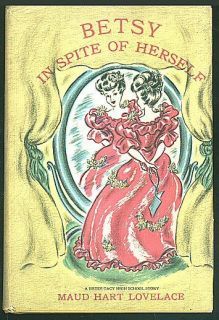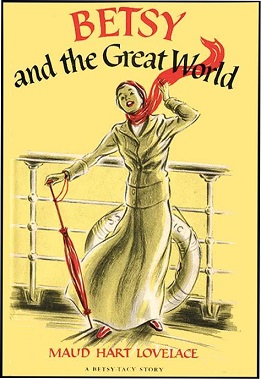
The Big Bad Wolf is a fictional wolf appearing in several cautionary tales, including some of Grimms' Fairy Tales. Versions of this character have appeared in numerous works, and it has become a generic archetype of a menacing predatory antagonist.
John Patrick was an American playwright and screenwriter.

A Few Quick Ones is a collection of ten short stories by P. G. Wodehouse. It was first published in the United States on 13 April 1959 by Simon & Schuster, New York, and in the United Kingdom on 26 June 1959 by Herbert Jenkins, London. The first US edition dust jacket was designed by Paul Bacon. The book's title comes from the informal phrase "a quick one", which is British slang for an alcoholic drink consumed quickly.

Rainbow Valley (1919) is the seventh book in the chronology of the Anne of Green Gables series by Lucy Maud Montgomery, although it was the fifth book published. While Anne Shirley was the main protagonist of the previous books, this novel focuses more on her six children and their interactions with the children of Anne's new neighbour, Presbyterian minister John Meredith. The work draws heavily on Montgomery's own life in the Leaskdale Manse, where she wrote a large number of books.

Maud Hart Lovelace was an American writer best known for the Betsy-Tacy series.
The Sisters Grimm is a children's fantasy series written by Michael Buckley and illustrated by Peter Ferguson. The series features two sisters, Sabrina Grimm and Daphne Grimm, and consists of nine novels that were published from 2005 to 2012.
The Betsy-Tacy books are a series of semi-autobiographical novels by American novelist and short-story writer Maud Hart Lovelace (1892-1980), which were originally published between 1940 and 1955 by the Thomas Y. Crowell Co. The books are now published by HarperCollins. The first four books were illustrated by Lois Lenski and the remainder by Vera Neville.

Betsy-Tacy (1940) is the first volume in the Betsy-Tacy series by Maud Hart Lovelace.

Betsy's Wedding (1955) is the tenth and final book in the Betsy-Tacy series written by Maud Hart Lovelace. Set in Minneapolis, Minnesota, the book tells the story of the early married life of the main character, Betsy Ray, and her high-school sweetheart, Joe. The characters of Tacy Kelly and Tib Muller also recur in this novel, as they did in all the novels covering the high-school years. The book, along with the entire Betsy-Tacy and Deep Valley series, was republished in 2000 by HarperTrophy with a new cover art illustrated by Michael Koelsch.

Betsy and Tacy Go Over the Big Hill (1942) is the third volume in the Betsy-Tacy series by Maud Hart Lovelace. The book, along with the entire Betsy-Tacy and Deep Valley series, was republished in 2000 by HarperTrophy with a new cover art illustrated by Michael Koelsch.

Betsy and Tacy Go Downtown (1943) is the fourth volume in the Betsy-Tacy series by Maud Hart Lovelace. The book, along with the entire Betsy-Tacy and Deep Valley series, was republished in 2000 by HarperTrophy with a new cover art illustrated by Michael Koelsch.

Heaven to Betsy (1945) is the fifth volume in the Betsy-Tacy series by Maud Hart Lovelace. Heaven to Betsy, describing Betsy's first year in high school, is written for an older age group than the earlier Betsy-Tacy books. The book, along with the entire Betsy-Tacy and Deep Valley series, was republished in 2000 by HarperTrophy with a new cover art illustrated by Michael Koelsch.

Betsy in Spite of Herself (1946) is the sixth volume in the Betsy-Tacy series by Maud Hart Lovelace. The book, along with the entire Betsy-Tacy and Deep Valley series, was republished in 2000 by HarperTrophy with a new cover art illustrated by Michael Koelsch.

Betsy Was a Junior (1947) is the seventh volume in the Betsy-Tacy series by Maud Hart Lovelace. The story spans the title character's junior, or eleventh grade, year in high school. The book, along with the entire Betsy-Tacy and Deep Valley series, was republished in 2000 by HarperTrophy with a new cover art illustrated by Michael Koelsch.

Betsy and Joe (1948) is the eighth volume in the Betsy-Tacy series by Maud Hart Lovelace. This installment spans the title characters' senior, or twelfth grade, year in high school. The book, along with the entire Betsy-Tacy and Deep Valley series, was republished in 2000 by HarperTrophy with a new cover art illustrated by Michael Koelsch.

Betsy and the Great World (1952) is the ninth volume in the Betsy-Tacy series of children's fiction by Maud Hart Lovelace. The book, along with the entire Betsy-Tacy and Deep Valley series, was republished in 2000 by HarperTrophy with a new cover art illustrated by Michael Koelsch.

"The Wolf and the Seven Young Goats" is a fairy tale collected by the Brothers Grimm and published in Grimm's Fairy Tales. It is of Aarne-Thompson type 123.
Baby Bear and the Big, Bad, Wolf is a 1996 children's play by Chet Frame and Jan H. Wolfe. The show combines the fairy tales Little Red Ridinghood, Goldilocks and the Three Bears, The Three Little Pigs, and Hansel and Gretel.

The Big Bad Fox and Other Tales… is a 2017 French/Belgian animated anthology comedy film directed by Benjamin Renner and Patrick Imbert, adapted from Renner's own comic books The Big Bad Fox and Un bébé à livrer. Originally conceived as half-hour TV specials, the three segments are linked together by a frame narrative.
The Hedgehog, the Merchant, the King and the Poor Man is a Hungarian fairy tale collected by László Merényi and translated by folklorist Jeremiah Curtin.















